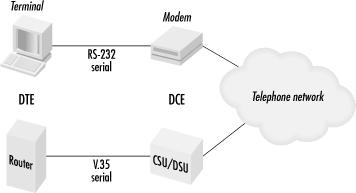Appendix E. Cable Pinouts and Serial Information
The most useful piece of learning for the uses of life is to unlearn what is untrue.
The telco’s responsibilities end at the demarc, and you are responsible for supplying a device to interface with their network. In many cases, the device is a modem; in others, it is a CSU/DSU. Most likely, your equipment will connect to the interface device using serial communications. This appendix contains a short introduction to serial communication basics, plus pinouts for the common interfaces used with T1 circuits.
Introduction to Serial Communications
In the most general sense, serial communications transfer a data stream between two devices one bit at a time. Serial links have, by definition, two devices, and two common setups are illustrated in Figure E-1.

Figure E-1. Two common serial links
The data terminal equipment (DTE) is the device where data is generated or consumed by users. The canonical example of a DTE is a dumb terminal, which displays data it receives and sends data in the form of user keypresses. Serial links also have devices called data communications equipment (DCEs), which are responsible for sending the bitstream to another location. In the dumb terminal setup, the DCE is a modem or terminal server. Routers often use high-speed serial links to connect to devices, which interface with the telephone network. ...
Get T1: A Survival Guide now with the O’Reilly learning platform.
O’Reilly members experience books, live events, courses curated by job role, and more from O’Reilly and nearly 200 top publishers.

